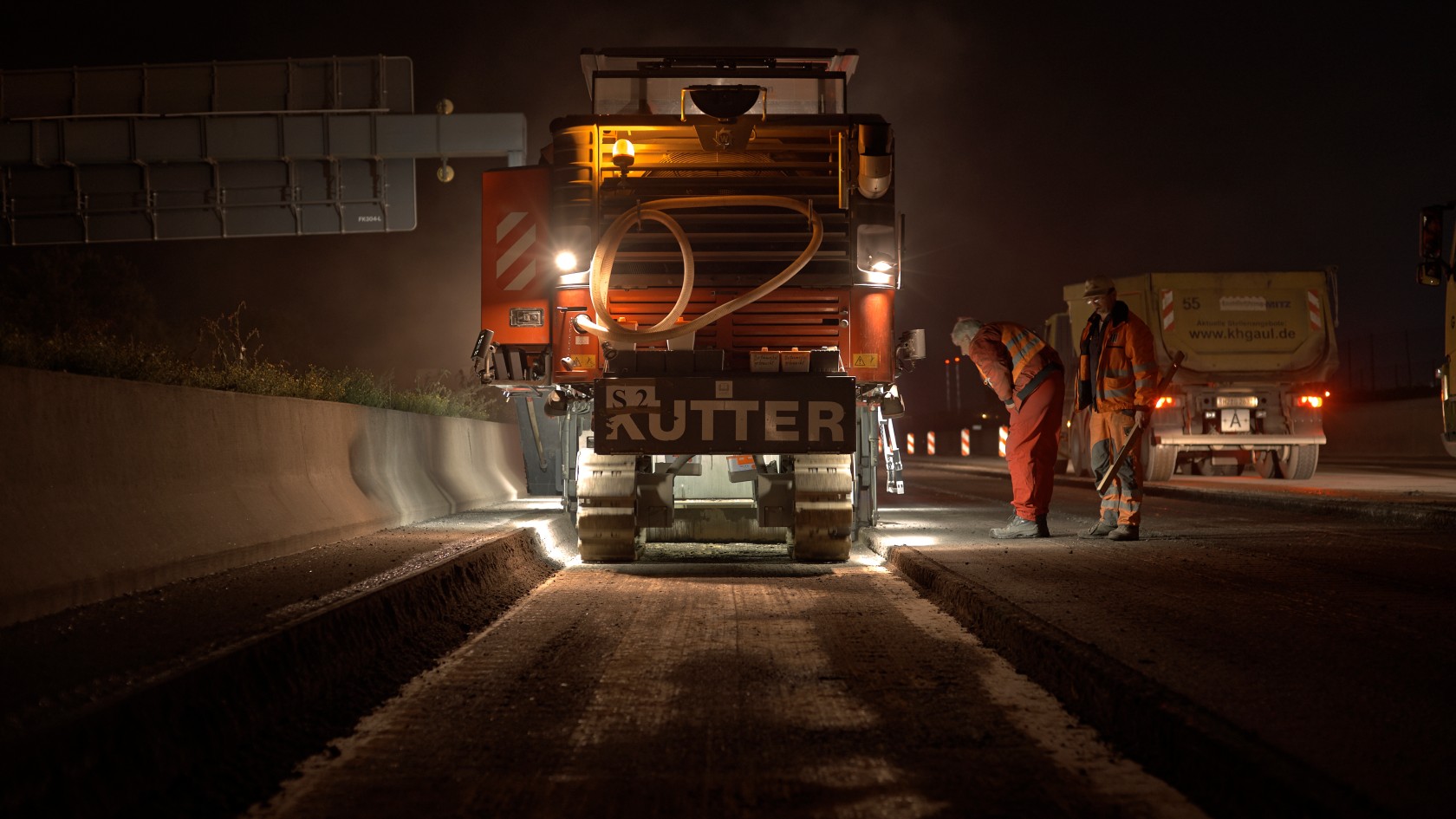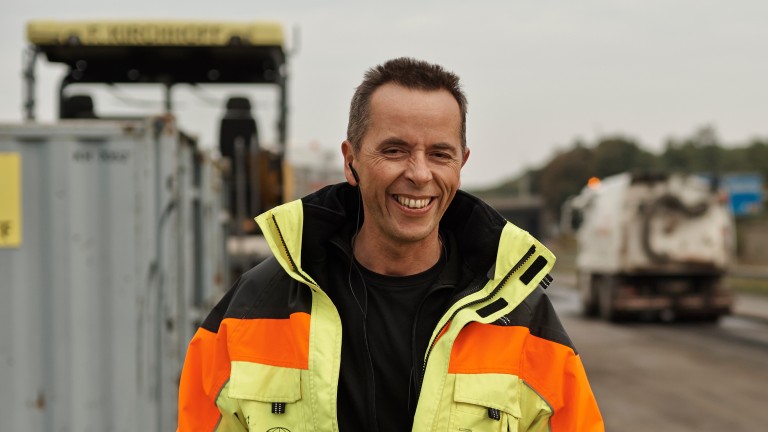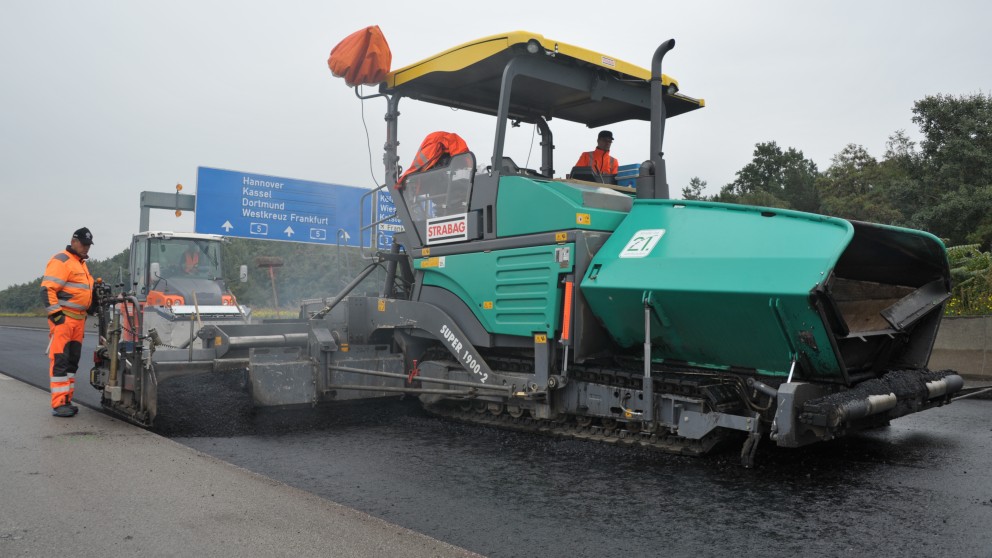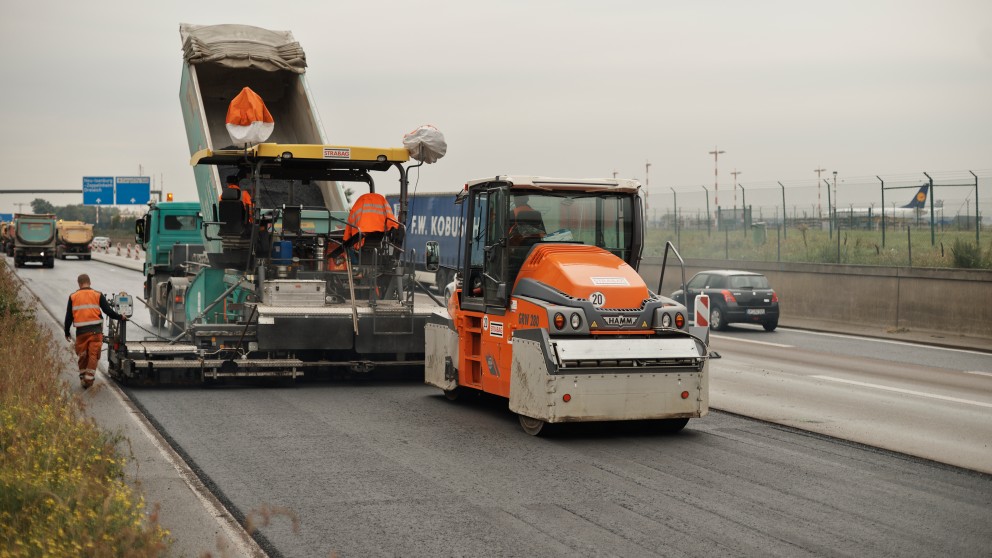Rehabilitating the roadways of Frankfurter Kreuz motorway junction


Rehabilitating the roadways of Frankfurter Kreuz motorway junction is the road construction equivalent of open-heart surgery. This is, after all, one of the most critical road traffic hubs in Germany, located in the direct vicinity of Frankfurt Airport. On average, some 135,000 vehicles use the junction every day. Such a high volume of traffic necessitates a meticulously planned rehabilitation project and the fastest possible project completion.
Just the thing for the machines of the Wirtgen Group, which took centre stage on the job site. They completed the task reliably and to a high standard of quality in less than 57 hours.
The demolition of a bridge on the A5 at Darmstädter Kreuz motorway junction just a few kilometres south of the Frankfurter Kreuz junction had become unavoidable. The busy A5 motorway had to be blocked to this end, providing the ideal opportunity to simultaneously carry out the urgently needed rehabilitation of the Frankfurt motorway junction. Indeed, the majority of traffic had already been re-routed, so the risk of congestion was low.
The perfect time for carrying out the work was between 3 and 6 October 2013. This year, German Unity Day – celebrated on 3 October – fell on a Thursday, and a long weekend with little traffic was expected. Consequently, Hessen Mobil planned the A5 rehabilitation work for this period. This meant that everything had to be finished within 57 hours from the time of blocking traffic to re-opening the completely rehabilitated sections, i.e. in 2 days and 3 nights.
No time to waste: the roller is already fully fuelled and rearing to go while the milling machine removes the last cubic metres of binder course.
The roadway was repaired in both directions at a total of six locations, equating to a surface area of roughly 18,200 m². The project allowed no margin for errors, as "blocking this stretch of the A5 in both directions a second time isn't on the cards," said Burkhard Vieth, President of Hessen Mobil. The contingent of personnel and equipment assigned to the €1.6 million project was correspondingly high: about 50 personnel were actively involved directly on the job site. Additionally, 63 lorries shuttled back and forth at peak times during the rehabilitation work
The project planners allowed traffic to continue using the motorway on the national holiday , but the machines were ready to go: immediately after the motorway was blocked at 10 pm, nine large milling machines and three compact milling machines started ploughing through the roadway surface. Depending on the condition, they only milled away surface and binder courses in some places, while in others they removed the entire asphalt pavement and in two sub-sections an additional 32 cm of hydraulically bound base course. Those areas where the hydraulically bound base course and overlaying asphalt layers had to be renewed were particularly critical in terms of scheduling. There was definitely tension in the air...
Jörg Freitag, Regional Director, SAT
Jörg Freitag, Regional Director at milling service provider SAT, a company in the STRABAG Group, coordinated the operations of the cold milling machines. The asphalt was removed layer-by-layer in order to separate the valuable milled material and permit optimum recycling later. The planners had already provided for sufficient lorry capacity, so the high-performance machines were able to really flex their mechanical muscles and achieved milling rates in excess of 200 t/h per machine. It was essential to the overall process that the milling work progressed quickly. A technician was on site just to make certain. "However, our workshop foreman didn't have to intervene – everything ran smoothly once again," summarized Jörg Freitag, as the last milling machines left the job site after 14 hours.
The crews readied the first pavers and rollers while it was still dark so that they could commence the asphalt paving work on the completely milled sections come daybreak. Here, too, STRABAG deployed machines from the Wirtgen Group. Hamm compactors and rubber-wheeled rollers were used to compact the rehabilitated hydraulically bound base course, while Vögele pavers and Hamm rollers handled the lion's share of the asphalt paving work.
Coordinating the placement of five different types of mix from five mixing plants within just 36 hours was a huge logistical challenge. A total of 10,000 t had to be delivered to the right job site, supplying the right asphalt mix at the right time with as many as 30 lorries. Yet everything went without a hitch thanks to meticulous planning, clearly assigned responsibilities and the use of four Vögele SUPER 1900-2 pavers. And the results of the work were also impressive: "The Vögele pavers produce a top pavement quality, especially with large pave widths like on the A5, where the pave widths extended to 7.80 m. The screeds also achieve a high degree of uniform pre-compaction across the entire width," said Technical Division Manager Georg Müller when describing the advantages of his road pavers.
Precise timing: come 6 am, the base course was laid down on both left-hand lanes in a segment covering 3,875 m² in the direct vicinity of Frankfurt Airport. Work on laying the binder course had already commenced at midday.
The GRW 280 rubber-wheeled rollers from Hamm also played a key role, providing the initial compaction directly behind the pavers. These were followed by various tandem rollers, including all-wheel-drive machines from the DV series and articulated machines from the HD series with different operating weights. The technology of the Hamm machines impressed STRABAG with features such as smooth automatic reversing, which allows high compaction quality without bumps or deformations. From an operator perspective, the compaction specialists of the Wirtgen Group deserve particular praise for the excellent view of the surroundings and the comfortable operator's platforms in all machine series.
GRW 280 and Super 1900-2: a seasoned team for guaranteed results.
All asphalt layers had been laid down by 6 pm on Saturday, despite heavy rainfall the night before having seriously delayed some of the work – a potential crisis with such a tight schedule. Still, all's well that ends well! Once the new road surface had cooled sufficiently by 6 am on Sunday, Hessen Mobil gave the order to re-open the rehabilitated stretch to traffic after just 57 hours. And since then, the traffic volume has once again reached 135,000 vehicles per day.
In addition to the quality of the machines, good training on the part of the operating crews is also a key factor for the success of a project. In Wirtgen Group training courses, professional instructors impart a wealth of expertise on machines and asphalt paving and removal, from settings and operation, all the way to maintenance and the minor troubleshooting. This has a positive impact on the performance, service life and availability of the machines.
Georg Müller, Technical Division Manager



